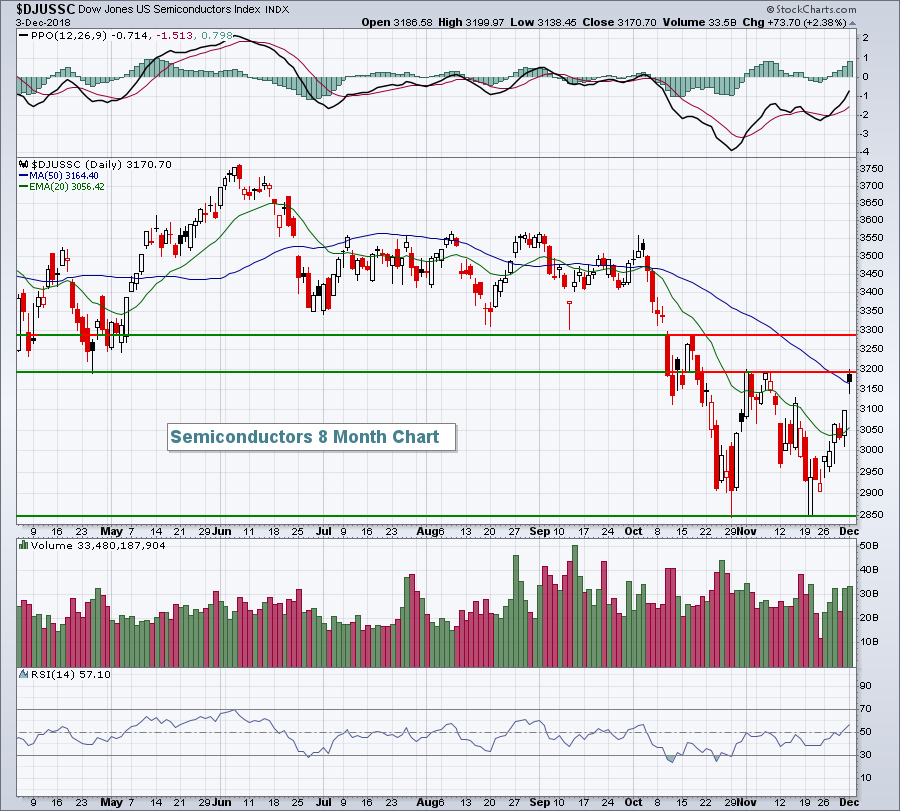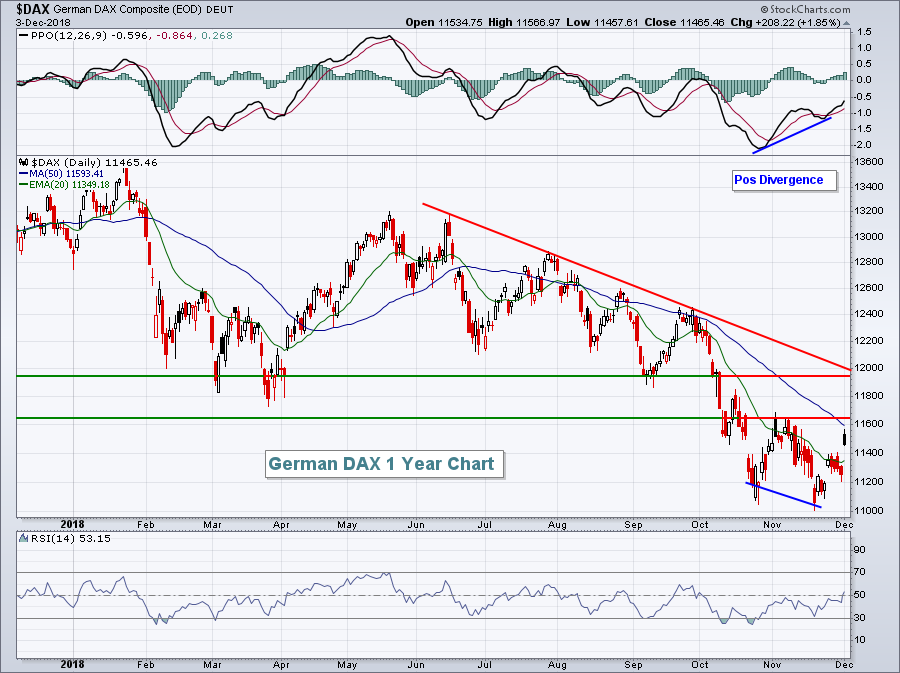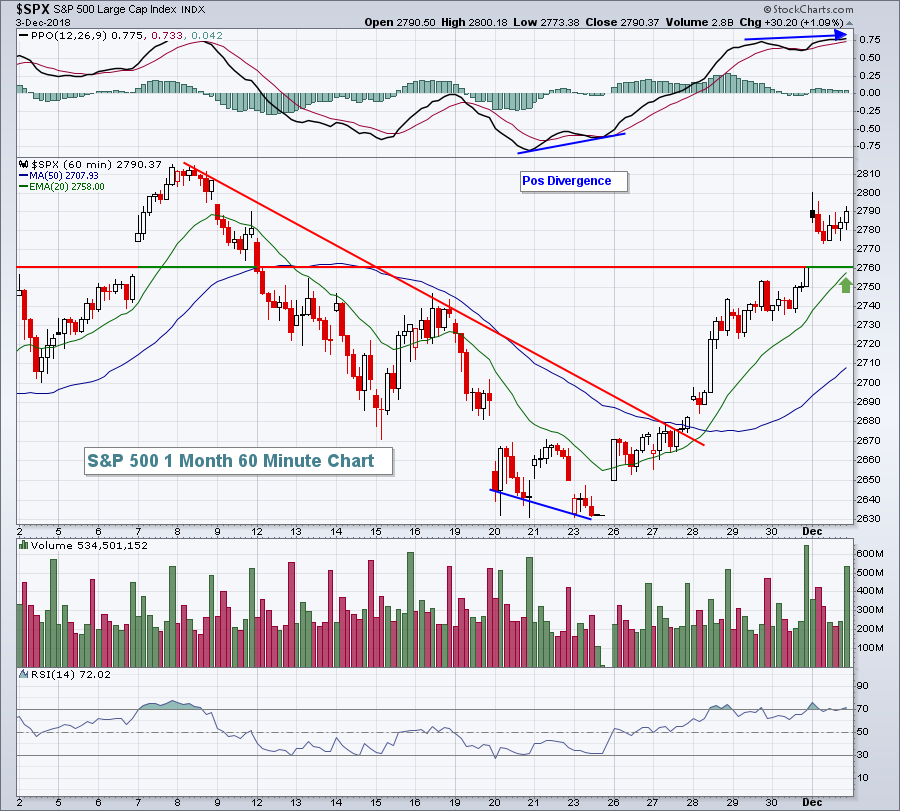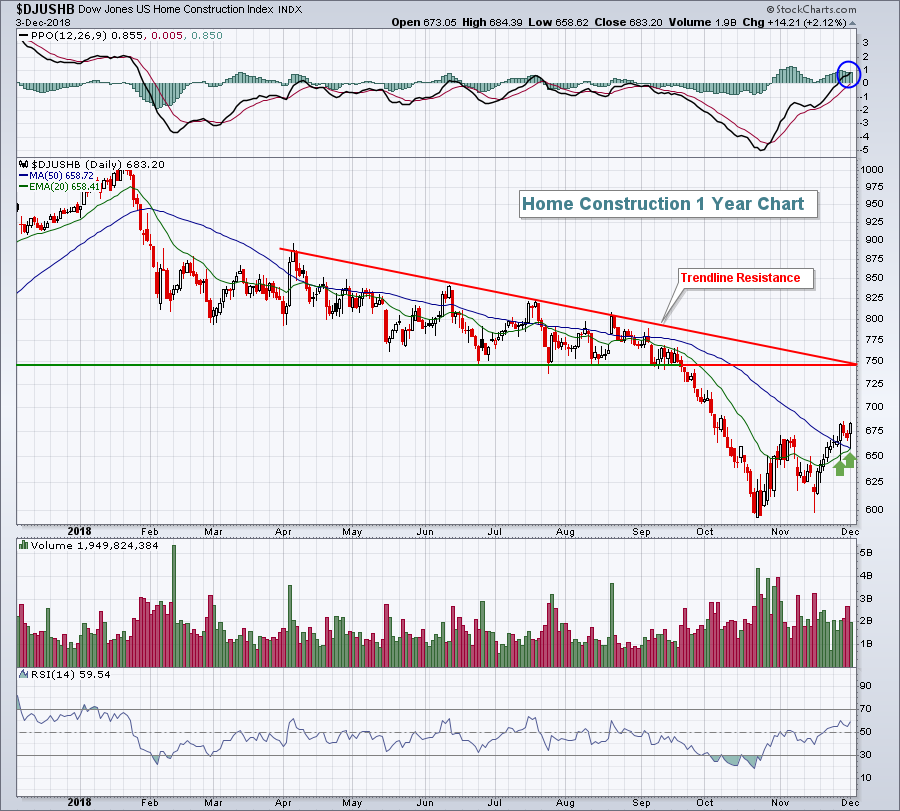Market Recap for Monday, December 3, 2018
Global stocks were buoyed on Monday by the United States and China agreeing to delay further tariffs for 90 days to provide the two countries an opportunity to work through its trade differences. Obviously, nothing has been resolved and it simply pushes back the effect of higher tariffs. Nonetheless, buyers emerged. All of the major indices in the U.S. climbed more than 1%, led by the more aggressive NASDAQ, which gained 1.51%. Energy (XLE, +2.22%) and technology (XLK, +2.21%) were the two clear sector winners, although consumer discretionary (XLY, +1.87%) and materials (XLB, +1.76%) also outperformed. The only sector to lose ground was healthcare (XLV, -0.48%), ironically the highest SCTR-ranked sector heading into Monday's action.
One area within technology that had a strong session yesterday, but will be worth watching is semiconductors ($DJUSSC, +2.38%). The group is now testing its earlier reaction high in November near 3200. Also, the DJUSSC managed to barely close above its 50 day SMA. What happens from here could have a meaningful impact not only on technology, but also on the NASDAQ:
 Semiconductors is an area that's been hurt by the trade issues with China. A resolved conflict will likely benefit this group as much as any other and that was somewhat reflected in their strength on Monday after the "cease fire" was announced.
Semiconductors is an area that's been hurt by the trade issues with China. A resolved conflict will likely benefit this group as much as any other and that was somewhat reflected in their strength on Monday after the "cease fire" was announced.
Pre-Market Action
Overnight, the Tokyo Nikkei ($NIKK) fell 539 points, or 2.39%, just one day after it managed to eke out a close above its 50 day SMA. Other Asian markets clung mostly to fractional gains at their respective closes last night. In Europe this morning, we're seeing a bit of profit taking after solid gains on Monday. The German DAX ($DAX) is the one index that tends to mimic the S&P 500 and, therefore, the European index that I follow most closely. Currently, there's a positive divergence in play that typically sees one of two things follow - either we see (1) a 50 day SMA test and PPO centerline "reset", or (2) a breakout above that 50 day SMA and PPO centerline with the positive divergence marking a significant price bottom. Here's the chart:
 Overhead resistance from roughly 11600-12000 will tell the technical story here. Yes, the positive divergence suggests that bearish price momentum is slowing, but that can be just temporary. Once price resistance and the PPO centerline are tested, we could see resumption of the prior downtrend. If the German DAX price action remains strong and we can clear the 11600-12000 range, then that would provide a boost for the S&P 500 bulls.
Overhead resistance from roughly 11600-12000 will tell the technical story here. Yes, the positive divergence suggests that bearish price momentum is slowing, but that can be just temporary. Once price resistance and the PPO centerline are tested, we could see resumption of the prior downtrend. If the German DAX price action remains strong and we can clear the 11600-12000 range, then that would provide a boost for the S&P 500 bulls.
Gold ($GOLD) is on the verge of a significant short-term breakout above $1240 per ounce. At last check, GOLD was up $7 to $1246. Crude oil ($WTIC) is also continuing to rebound off its massive October-November slump. The WTIC is up 2% to $54 per barrel. Technically, I'd expect to see resistance closer to $56 per barrel as that's where the initial 20 day EMA test would be.
Dow Jones futures are pointing to profit taking this morning, lower by 99 points with 30 minutes left to the opening bell.
Current Outlook
Yesterday, I'll admit I had my doubts midway through the session. The S&P 500, along with all of our major indices, gapped significantly higher at the open, but the gains were steadily eroding during the morning session. However, strength resumed in the afternoon and, in my opinion, that's left the door open for potentially higher prices in the very near-term:
 Buying in the afternoon is normally a fairly good sign of sustainability in a short-term rally. That doesn't mean we won't see a bit of short-term profit taking and this morning's futures are pointing to just that. There's key short-term support now near 2760. Gap support is at 2760.17 and the 20 hour EMA is at 2758. Testing that level with a rising 20 hour EMA would be fine, although we'd have to watch the hourly PPO closely as the next price move higher could result in a negative divergence. Those 60 minute negative divergences can be helpful in identifying pivot points on the chart just as the positive divergence accompanied the recent price low.
Buying in the afternoon is normally a fairly good sign of sustainability in a short-term rally. That doesn't mean we won't see a bit of short-term profit taking and this morning's futures are pointing to just that. There's key short-term support now near 2760. Gap support is at 2760.17 and the 20 hour EMA is at 2758. Testing that level with a rising 20 hour EMA would be fine, although we'd have to watch the hourly PPO closely as the next price move higher could result in a negative divergence. Those 60 minute negative divergences can be helpful in identifying pivot points on the chart just as the positive divergence accompanied the recent price low.
Sector/Industry Watch
I've discussed home construction ($DJUSHB) on many occasions and their seasonal trends can be found under the Historical Tendencies section below. The technical picture has been improving, too, in the face of not-so-great economic news, a bullish sign:
 Let me clear about one thing. I am not suggesting that home construction's definitive bottom is in. Instead, I'm simply saying that the technical picture is improving and the short-term technical action is bullish as bounces off a rising 20 day EMA (green arrows) is very positive behavior given the bullish PPO centerline crossover. The weekly chart has much more work to do. In fact, its declining 20 week EMA is rapidly approaching, currently residing at 698.
Let me clear about one thing. I am not suggesting that home construction's definitive bottom is in. Instead, I'm simply saying that the technical picture is improving and the short-term technical action is bullish as bounces off a rising 20 day EMA (green arrows) is very positive behavior given the bullish PPO centerline crossover. The weekly chart has much more work to do. In fact, its declining 20 week EMA is rapidly approaching, currently residing at 698.
Historical Tendencies
Over the past two decades, the home construction index ($DJUSHB) has gained nearly 15% per year. But one of the most perplexing seasonal facts is that the DJUSHB earns more than 50% of its returns over this period during two winter months - December (+4.8%) and January (+3.0%). During the warmer months of May through September, the DJUSHB has been FLAT.
Key Earnings Reports
(actual vs. estimate):
AZO: 13.47 vs 12.21
BMO: 1.78 vs 1.75
DCI: .56 vs .57
DG: 1.26 vs 1.26
HDS: 1.00 vs .98
TOL: 2.08 vs 1.82
(reports after close, estimate provided):
HPE: .43
HQY: .25
MRVL: .32
OLLI: .31
Key Economic Reports
None
Happy trading!
Tom
